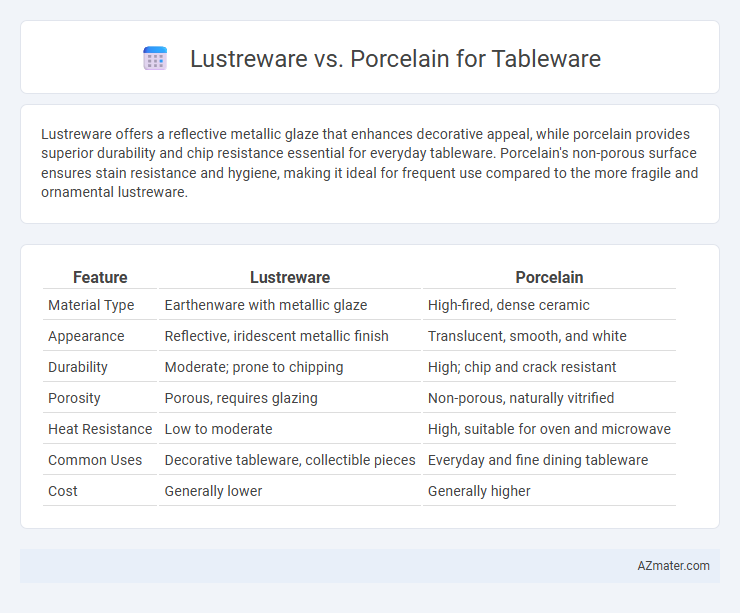Lustreware offers a reflective metallic glaze that enhances decorative appeal, while porcelain provides superior durability and chip resistance essential for everyday tableware. Porcelain's non-porous surface ensures stain resistance and hygiene, making it ideal for frequent use compared to the more fragile and ornamental lustreware.
Table of Comparison
| Feature | Lustreware | Porcelain |
|---|---|---|
| Material Type | Earthenware with metallic glaze | High-fired, dense ceramic |
| Appearance | Reflective, iridescent metallic finish | Translucent, smooth, and white |
| Durability | Moderate; prone to chipping | High; chip and crack resistant |
| Porosity | Porous, requires glazing | Non-porous, naturally vitrified |
| Heat Resistance | Low to moderate | High, suitable for oven and microwave |
| Common Uses | Decorative tableware, collectible pieces | Everyday and fine dining tableware |
| Cost | Generally lower | Generally higher |
Introduction to Lustreware and Porcelain
Lustreware is a type of pottery characterized by its shimmering metallic glaze that creates an iridescent effect, often used for decorative tableware. Porcelain, a high-fired ceramic made from kaolin clay, is prized for its strength, translucency, and smooth, white surface commonly used in fine dining settings. Both materials offer distinct aesthetic and functional qualities, making them popular choices for different styles of tableware.
Historical Origins and Development
Lustreware emerged in the early 19th century, characterized by its metallic glaze and was primarily produced in England and Staffordshire, influencing decorative tableware with its iridescent finish. Porcelain, with origins dating back to the Tang Dynasty in China around the 7th century, developed into a highly refined ceramic known for its translucency and strength, spreading to Europe by the 16th century through trade. The historical development of both materials reflects distinct technological advancements, with lustreware focusing on surface decoration techniques and porcelain emphasizing material innovation and durability.
Material Composition and Production Techniques
Lustreware features a metallic glaze achieved by applying silver or gold compounds onto ceramics through a complex firing process, resulting in an iridescent, reflective surface typically on earthenware or stoneware. Porcelain is made from refined kaolin clay fired at high temperatures, producing a dense, white, and translucent material prized for its strength and non-porous quality. Production of lustreware involves multiple firings at lower temperatures to fix the metallic finish, whereas porcelain requires a single high-temperature firing to vitrify the clay body, highlighting distinct material compositions and manufacturing methods.
Visual Appeal and Aesthetic Differences
Lustreware features a distinctive metallic sheen with iridescent glazes that create a reflective, almost shimmering surface, enhancing its vintage charm and making it a striking choice for decorative table settings. Porcelain offers a smooth, translucent finish with a crisp white backdrop that highlights intricate patterns and fine detailing, exuding elegance and refinement suited for formal dining. The contrast between lustreware's vibrant, glossy surface and porcelain's delicate, matte or glossy finish defines their unique visual appeal and complements diverse tableware aesthetics.
Durability and Practicality in Everyday Use
Lustreware, known for its metallic glaze, offers a visually striking finish but tends to be less durable due to its delicate surface, making it prone to chipping and wear with frequent use. Porcelain, crafted from refined clay fired at high temperatures, excels in durability and resistance to scratches, making it highly practical for everyday tableware. Porcelain's non-porous surface also ensures easy cleaning and long-lasting appeal, while lustreware is best suited for decorative or occasional use to maintain its aesthetic quality.
Maintenance and Care Requirements
Lustreware requires delicate handling due to its metallic glaze, which can be easily damaged by abrasive cleansers or dishwashers, making handwashing with mild soap essential for maintaining its luster. Porcelain is more durable and can typically withstand dishwasher use, although avoiding sudden temperature changes and harsh chemicals is advised to prevent cracking and preserve its smooth finish. Both materials benefit from gentle cleaning and proper storage to extend their longevity and retain their aesthetic appeal.
Cost Comparison and Market Value
Lustreware typically costs less than porcelain due to its decorative glazing technique that's less expensive to produce, appealing to budget-conscious buyers in the vintage and artisanal markets. Porcelain commands higher prices because of its durability, fine craftsmanship, and association with luxury brands, making it a preferred choice for high-end tableware collections. Market value for porcelain remains stable or appreciates over time, while lustreware's value fluctuates more with trends and rarity.
Popular Designs and Cultural Significance
Lustreware features an iridescent glaze that creates a shimmering metallic effect, often showcasing intricate floral and geometric patterns popular in Victorian and Art Nouveau eras, reflecting European craftsmanship and decorative arts heritage. Porcelain, prized for its strength and translucency, boasts classic designs from East Asian influences such as delicate hand-painted scenes of nature and mythology, symbolizing cultural refinement and status in both Chinese and European traditions. The cultural significance of lustreware lies in its role as an ornamental art piece, while porcelain combines functionality with elegance, making it a staple in ceremonial and everyday table settings worldwide.
Sustainability and Environmental Impact
Lustreware, often characterized by its metallic glaze, involves complex firing processes and chemical treatments that can increase energy consumption and environmental pollutants compared to porcelain, which typically uses natural clay and simpler firing methods. Porcelain boasts higher durability and longevity, reducing the frequency of replacement and waste, making it a more sustainable choice for eco-conscious consumers. Choosing porcelain tableware supports lower carbon footprints and less resource-intensive production, aligning better with sustainable living principles.
Choosing the Right Tableware for Your Needs
Lustreware offers a distinctive iridescent finish that enhances aesthetic appeal and suits decorative or formal dining settings, while porcelain provides superior durability, chip resistance, and heat retention ideal for everyday use. When choosing tableware, consider the function and frequency of use; lustreware excels in visual impact but requires careful handling, whereas porcelain delivers versatility and practicality. Matching tableware to your lifestyle ensures a balance between elegance and functionality, with porcelain catering to long-term durability and lustreware adding artistic value.

Infographic: Lustreware vs Porcelain for Tableware
 azmater.com
azmater.com